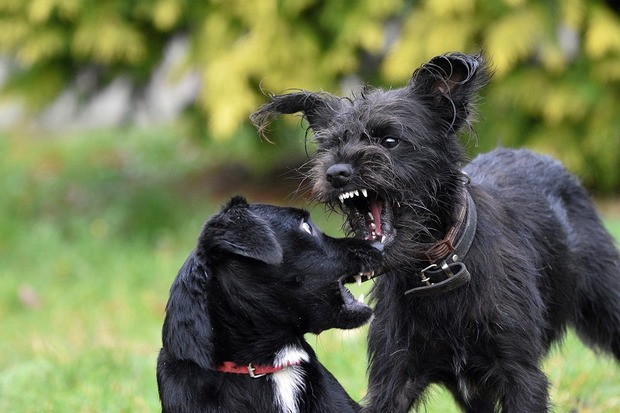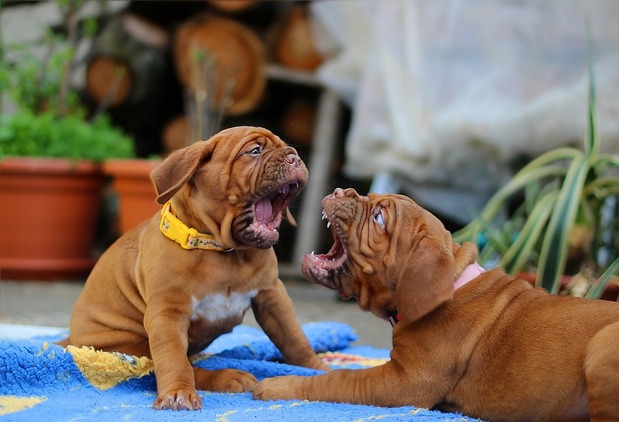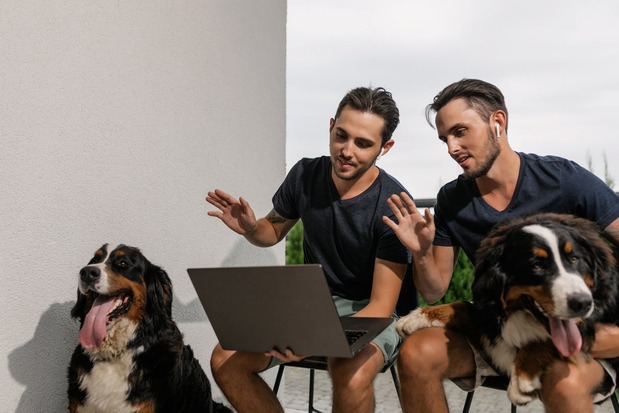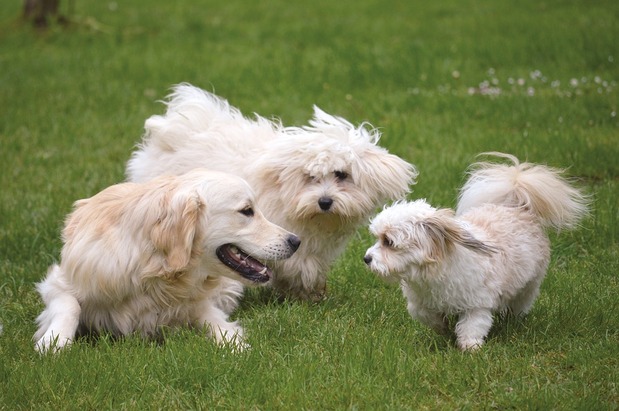2023-02-06
What is better than having a lovely paw friend at home? Having two paw friends, of course! Often the reality is likely to be totally different though. Owners of two or more dogs tend to face difficulties raising their canines together. Some of these difficulties are caused by a lack of enough space, money, or time to take care of multiple dogs, while others result from the inability of the dogs to get along with each other. The intolerance between family dogs, may escalate and easily turn into fighting. However, this “intolerance” has always its roots, and it depends on us as owners to identify these and address the unwanted behaviors it causes.

In order to properly address fighting as unwanted behavior, first we need to figure out what causes it. There are many reasons that can lead to a dog fight, however, we will list the most common ones below:
Resource guarding
Resource guarding is among the most common reasons for dogs to fight. It refers to all sorts of resources considered “valuable” by your dog, including food, territory, toys, or even toward the owner themselves. Some dogs create a very strong bond with their owners and can show a tendency to be clingy. If your dog feels neglected or jealous because of the attention his/her owners pay to the other dog in the household, he/she may show a negative reaction.
Lack of socialization
Socialization at a young age is crucial for dogs to be able to behave adequately around other animals and people. Socialization begins with the dog’s birth and the way he/she interacts with his/her mother and other pups from the litter and continues when they are brought to their new home. Dogs learn to recognize the behavior and pick up on the social cues of other dogs. If your dog has not been socialized properly at home and is unable to meet and interact with other dogs (well-behaved and vaccinated), he/she may lack social skills. This may result in the inability of your paw friend to properly interact with another dog in the household.
Anxiety / Stress
If left unaddressed, underlying anxiety or stress can cause a dog to attack another dog, even if the latter is not the cause of the anxiety. A dog can be stressed by certain triggers in the environment, which, when present, can cause a dog to overly react. Besides environmental stimuli, stress and anxiety can be caused by improper raising and training of a dog, i.e. using negative reinforcement as well as by separation from the owner. Separation anxiety is very common in puppies and can be outgrown in many cases. However, it also can remain a problem and needs to be addressed.
Routine & Environmental Changes
Dogs can be very sensitive toward any changes in their surroundings or routine. They are considered creatures of habit, who like predictability due to the feeling of safety it brings. Changes of any kind can lead to unwanted behaviors in your paw friend and these can include everything from rearranging the furniture, changing the food/water bowls or moving them to a new place at home, changing the diet and meal times, moving to a new home, welcoming a new family member (both a human or a new pet), moving or passing a family member...etc. Just like us, our paw friends also need time to adjust to the changes that may occur in their environment.
Emotional Neglect / Lack of Mental Stimulation
We need to take care not only of the physical health of our paw friend but also of his/her mental health. If we do not engage enough in various activities with our dog, he/she may feel emotionally neglected and develop behavioral issues. Mental exercise in the form of games or interaction with the owner is essential for the well-being of our beloved paw family members. If you can not figure out what games would be suitable for your doggy, here are a few suggestions:
-Puzzles;
-Toys with hidden treats;
-Stuffed Kong;
-Hide and seek game;
-Tug toys;
-Treat dispensing toys;
-Chase toys;
-The cup game (it is just the dog version of the human game).
Some of these games would be rewarding for both the physical and emotional health of your canine.
Over stimulation
Just like the lack of mental stimulation can negatively affect your dog, over stimulation can do the same. Over stimulation is often caused by the presence of stimuli i.e. the owner is arriving, guests are visiting, another dog is approaching (especially if both dogs or one of the dogs is on a leash), fence fighting (similar to the previous one, but this time the fence plays a role of a barrier which additionally arouses the dogs).
Lack of personal space
Lack of space can lead to conflicts between family dogs and even fighting. This can occur if two or more dogs share the same kennel or area at home, eat from the same food bowl share the same toys...etc. Also, if they need to spend a lot of time in an enclosed space, e.g. a car during a ride, they may come into conflict.
Improper Introduction
By “improper introduction” we mean forcing the process of socialization between the current dog in the household and the new one. Dogs have their own boundaries, and they should not be forced to accept another dog’s presence. You should be patient and make sure that there is a smooth transition to the new living arrangements.
Incompatible / Conflict Personalities
Some dogs are naturally friendly and social, while others are more stubborn and need more time to accept another dog or a person. If you have two or multiple dogs with conflicting personalities, you will need to invest time and work to help them accept each other.
Health Issues
Underlying medical issues and/or injuries may cause your dog to be irritated and behave aggressively. If your paw friend is in pain, he/she may also move to an isolated area and even hide.
Play
It can start as an innocent play and turn into a fight. This is common in badly socialized or very young dogs, who are still learning how to properly behave around other animals and people.

It is important that you are able to recognize the signs of a fight that is about to start and to take precautions.
The most common signs include:
Growling;
Pacing;
Barring teeth;
Starring;
Raising the ears/hackles;
Tucking the tail;
Showing whale eye.
In case your dog is in the same location as another dog whether a family dog or a dog you just met in the park and shows the signs listed above, you may need to create some distance as quickly as possible. You should always take the environment and the current situation into account. However, showing these signs in the presence of another dog is not likely to end well…

Using a device producing a loud sound such as an air horn is likely to startle the dogs, redirect their attention, and stop the fight.
Spray / Water
Other items that might come in handy are juice or vinegar spray, which will also startle the dogs. A cup of water or a hose may be useful as well. Of course, you should be careful to not spray them in the eyes or the ears.
Blanket
You may have never perceived your nice and warm blanket as a tool for stopping a dog fight, but here we are! Throw a blanket over your dogs. They won’t understand what is happening and while they are still not aware of the situation, you can quickly separate them.
Whether a dog gate or another item that will function as a barrier, it can be used to separate the dogs, thus preventing them from fighting.
Please note, that although a barrier/gate might be a suitable “tool” to stop a dog fight, it is not recommended for socialization purposes. Dogs who feel in any way restricted are more likely to show aggression toward each other when they meet.
If you do not have a break stick and do not intend to buy one (or two based on how many dogs you have), you can just utilize any items in your home that can be used for this purpose, e.g. a broom handle. Put it between the jaws and twist, in order for them to stay open. Then quickly move the dogs far from each other.
This is the last and least recommended option, because it may put you in danger. In case there is someone else to help you physically separate the dogs, you can give it a try (if none of the options listed above has worked, or you are unable to try it). You and the other person, if there is such will need to go behind each of the dogs, grab him/her on the back legs and slightly move them up. That way the dog will need to balance on his/her front legs. Move in the opposite direction, in order for the distance between the dogs, to increase, until they are far enough from each other.
Keep in mind that dogs who have already started to fight and are highly aroused, even if they are your family dogs, and love you, can bite you.

As mentioned above socialization plays an essential role in our paw friends’ lives and ensures that they will become well-mannered family and society members. It will also help them avoid any troublesome situations when they become adults.
If you need to make any changes in your dog’s routine or environment, you should make these step by step. Give your dog time to adjust. If situations have occurred, which are outside your control, i.e. a family member has died or moved, try to make your dog feel as comfortable as possible-show him/her your love, provide him/her with toys, and plush items, engage in play sessions with him/her, walk him/her exercise him/her, train him/her. By redirecting his/her attention and showing him/her how much you care about him/her, he/she is likely to overcome the loss more quickly. Of course, such changes always take time…
If your dog is acting aggressively due to underlying stress or anxiety, you should identify the cause and take action. You may need to avoid a certain place, remove a certain item from the surroundings, put the curtains down, or otherwise obstruct your dog’s access to the window, where he/she may be exposed to different views and sounds.
Also, you may need to apply desensitization and counter-conditioning. Desensitization is a term used to describe the process of exposing the dog to stimuli at a really low level, where no reaction will follow. The intensity of the stimuli should increase gradually.
Counter-conditioning describes the process of changing the dog’s attitude toward the stimuli, by providing him/her with a positive experience, i.e. rewarding the dog in the presence of the triggers. Over time, the dog is likely to change his/her attitude. Be careful though, as counter-conditioning may have the opposite effect if the stimuli have an extremely negative effect on the dog. If your dog is frightened, and you start feeding him/her treats, he/she may start associating food with a negative experience. Make sure to use desensitization first.
If you are about to welcome a new paw friend into the family, make sure that you will be doing it the right way. This may include arranging a meeting in a neutral area (where territorial instincts won’t be shown) and giving the dogs time to sniff each other, greet each other and get used to each other’s scent. If the meeting went well, you can then walk the dogs to your garden/backyard and let them continue playing there (under supervision) prior to allowing them indoors.
Also, if your current dog shows good manners, you may consider keeping him/her off-leash while introducing the new paw family member. Introducing dogs on leash may arouse them. If the new pet calmly explores his/her new home, while being on a leash, and your current dog also behaves well, you can remove his/her leash as well.
Make sure that your paw friends as well as all other pets you may raise together have their personal area at home, including their own food and water bowls, toys, and bedding. That way you will prevent the dogs from fighting for resources.
Basic obedience training is something that always comes in handy! It will teach your dog good manners and how to control his/her impulses. Tasks like “sit”, “stay”, “come”, “leave” and “down” will be very beneficial for improving your dog’s behavior.
Never neglect your canine’s physical and mental health. Walk him/her regularly, provide him/her with interesting toys and play with him/her. Some breeds such as the German Shepherd are highly energetic and need a lot of mental and physical stimulation to remain fit and not develop behavioral issues.
Annual veterinarian checks, regular vaccination, and parasite control should be mandatory for you as a dog owner. These procedures will help you keep track of your canine’s health and take action in a timely manner if a health condition or some kind of injury is present.